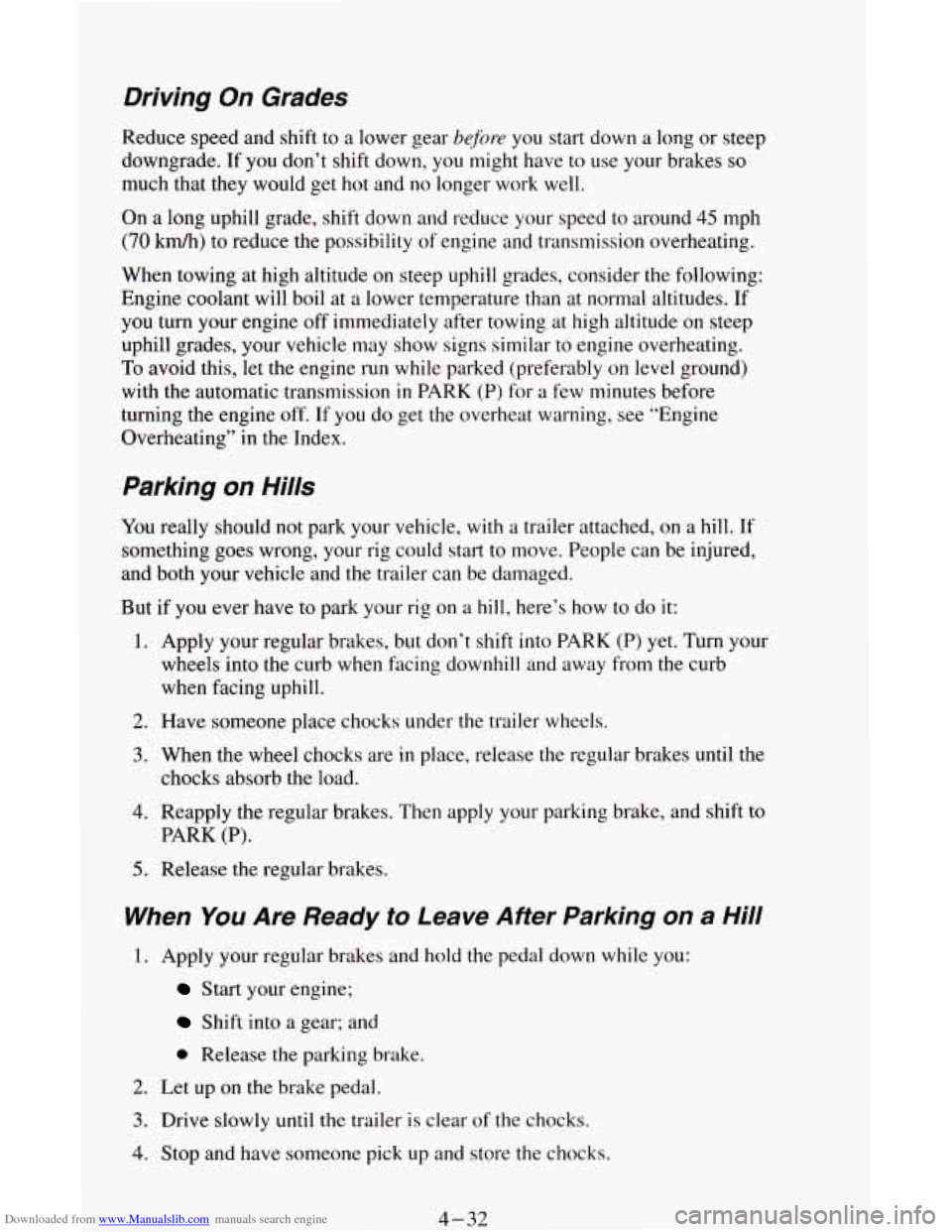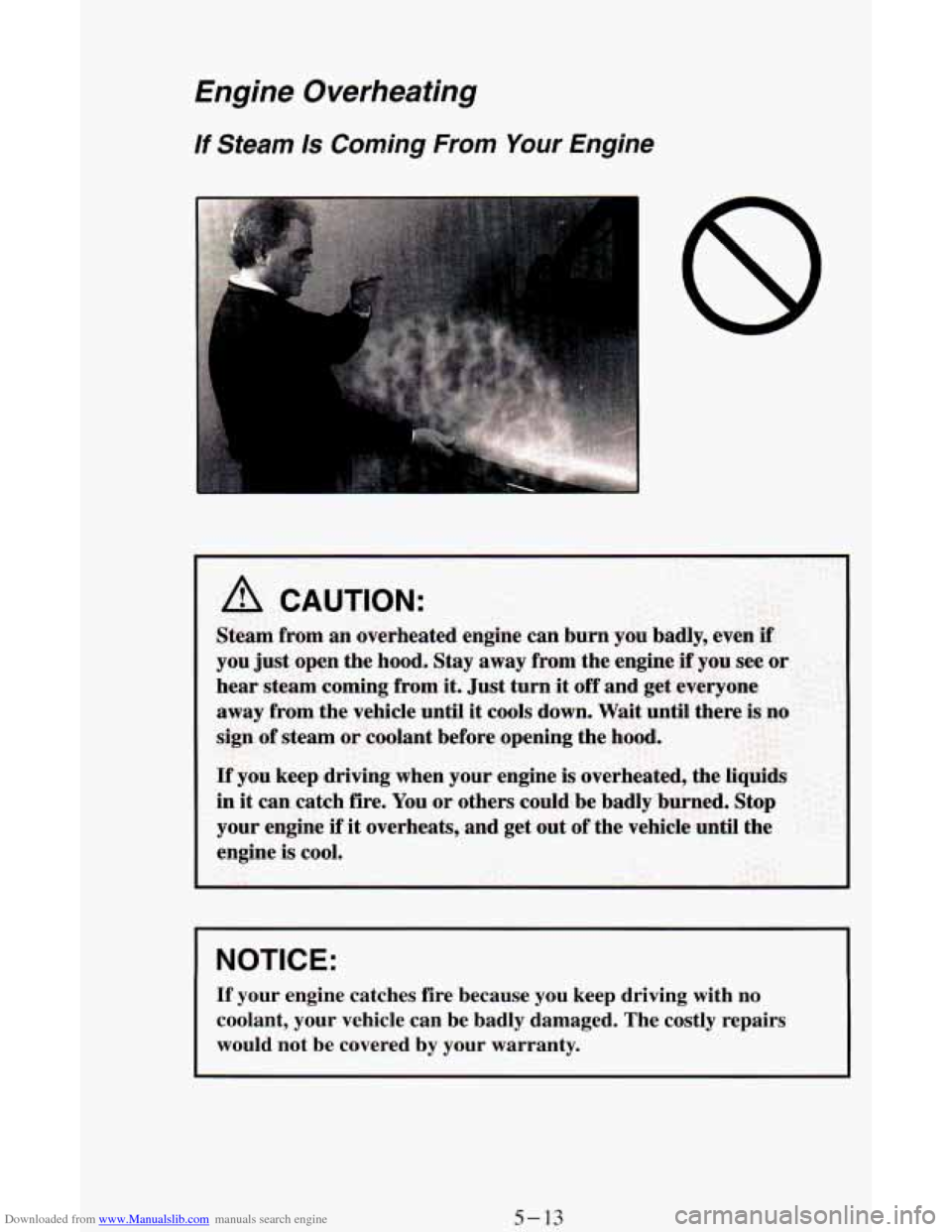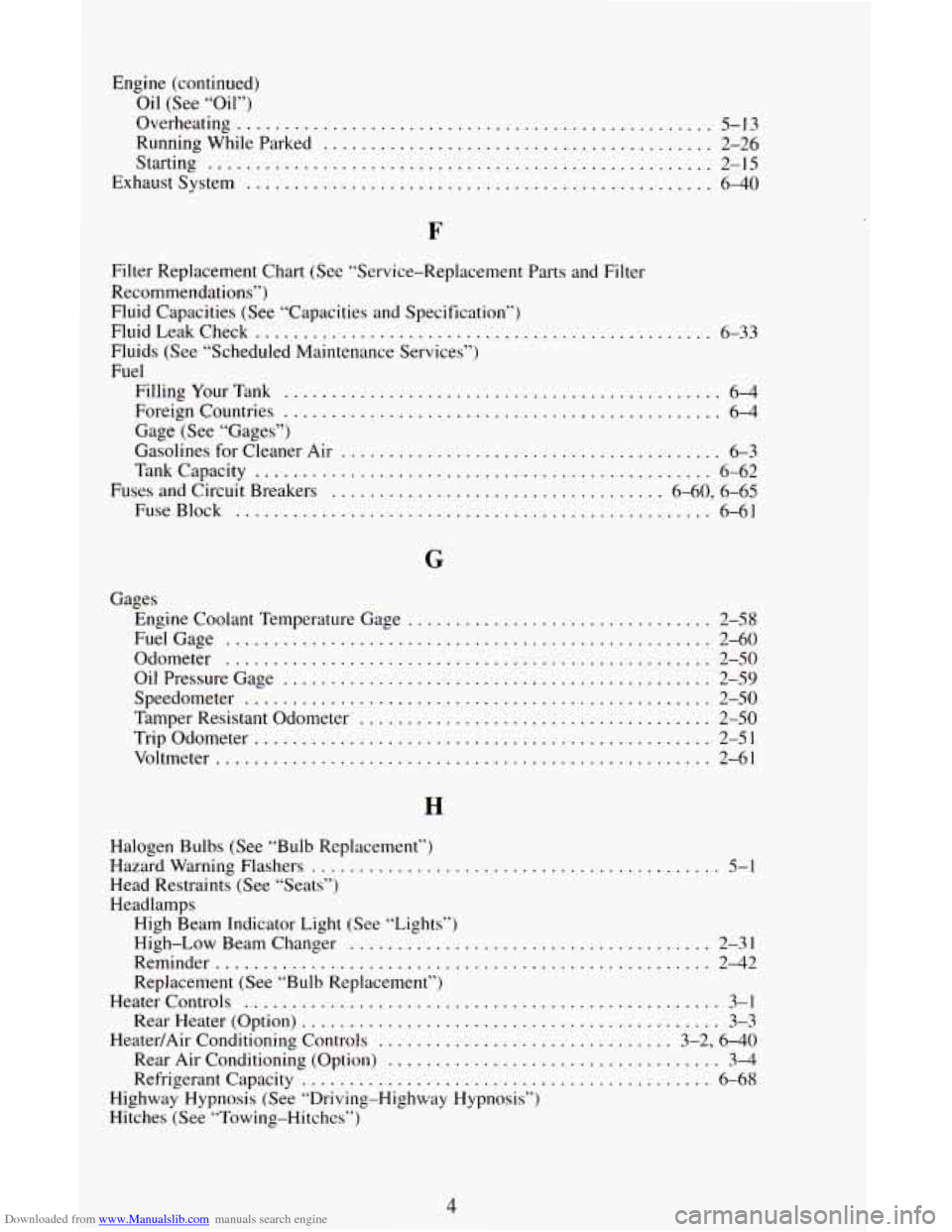1995 CHEVROLET ASTRO CARGO VAN overheating
[x] Cancel search: overheatingPage 5 of 342

Downloaded from www.Manualslib.com manuals search engine Table of Contents
Introduction - How to Use this Manual
This section tells you how to use your manual and includes safety
and vehicle damage warnings and symbols.
Section 1 - Seats and Restraint Systems
This section tells you how to use your seats and safety belts
properly. It also explains the air bag system.
Section 2 - Features & Controls
This section explains how to start and operate your vehicle.
Section 3 - Comfort Controls & Audio Systems
This section tells you how to adjust the ventilation and comfort
controls and how
to operate your audio system.
Section 4 - Your Driving and the Road
Here you’ll find helpful information and tips about the road and
how
to drive under different conditions.
Section 5 - Problems on the Road
This section tells you what to do if you have a problem while
driving, such as a flat tire or engine overheating, etc.
Section 6- Service & Appearance Care
Here the manual tells you how to keep your vehicle running
properly and looking good.
Section 7 - Maintenance Schedule
This section. tells you when to perform vehicle maintenance and
what fluids and lubricants to use.
Section 8 - Customer Assistance Information
This section tells you how to contact GM for assistance and how to
get service publications. It also gives you information on
“Reporting Safety Defects” on page
8-4.
Index
Here’s an alphabetical listing of almost every subject in this
manual. You can use
it to quickly find something you want to read.
1
Page 112 of 342

Downloaded from www.Manualslib.com manuals search engine Englne Coolant Temperature Gage
Standard Cluster Digital Cluster
If you have the standard cluster, you have a gage that shows the engine
coolant temperature. If the gage pointer moves to the
“H” (red) side, your
engine is
too hot!
It means that your engine coolant has overheated. If you have been
operating your vehicle under normal driving conditions, you should pull off
the road, stop your vehicle and turn
off the engine as soon as possible.
If you have
a digital cluster, a box around the temperature symbol will also
flash when your engine is too hot.
In “Problems on
the Road,” this manual explains what to do. See “Engine
Overheating”
in the Index.
2-5 8
Page 170 of 342

Downloaded from www.Manualslib.com manuals search engine Driving On Grades
Reduce speed and shift to a lower gear before you start down a long or steep
downgrade. If
you don’t shift down, you might have to use your brakes so
much that they would get hot and no longer work well.
On a long uphill grade, shift down and reduce your speed to around
45 mph
(70 km/h) to reduce the possibility of engine and transmission overheating.
When towing at high altitude
on steep uphill grades, consider the following:
Engine coolant will boil at
a lower temperature than at normal altitudes. If
you turn your engine off immediately after towing at high altitude on steep
uphill grades, your vehicle may show signs similar to engine overheating.
To avoid this, let the engine run while parked (preferably on level ground)
with the automatic transmission
in PARK (P) for a few minutes before
turning the engine off. If you do get the overheat warning, see “Engine
Overheating”
in the Index.
Parking on Hills
You really should not park your vehicle, with a trailer attached, on a hill. If
something goes wrong, your rig could start to move. People can be injured,
and both your vehicle and the trailer can be damaged.
But if
you ever have to park your rig on a hill, here’s how to do it:
1. Apply your regular brakes, but don’t shift into PARK (P) yet. Turn your
wheels into the curb when facing downhill and away from the curb
when facing uphill.
2. Have someone place chocks under the trailer wheels.
3. When the wheel chocks are in place, release the regular brakes until the
chocks absorb the load.
4. Reapply the regular brakes, Then apply your parking brake, and shift to
5. Release the regular brakes.
PARK (P).
When You Are Ready to Leave After Parking on a Hill
1. Apply your regular brakes and hold the pedal down while you:
Start your engine;
Shift into a gear; and
0 Release the parking brake.
2. Let up on the brake pedal.
3. Drive slowly until the trailer is clear of the chocks.
4. Stop and have someone pick up and store the chocks.
4-32
Page 185 of 342

Downloaded from www.Manualslib.com manuals search engine Engine Overheating
If Steam Is Corning From Your Engine
-
8
I NOTICE:
If your engine catches fire because you keep driving with no
coolant, your vehicle can be badly damaged. The costly repairs
would not be covered by your warranty.
5-13
Page 231 of 342

Downloaded from www.Manualslib.com manuals search engine What to Use
Refer to the Maintenance Schedule to determine what kind of lubricant to
use. See “Recommended Fluids and Lubricants”
in the Index.
Engine Coolant
The following explains your cooling system and how to add coolant when it
is low. If you have a problem with engine overheating, see “Engine
Overheating”
in the Index.
The proper coolant
for your vehicle will:
0 Give freezing protection down to -34°F (-37°C).
0 Give boiling protection up to 262 OF ( 1 28 O C).
0 Protect against rust and corrosion.
0 Help keep the proper engine temperature.
0 Let the warning lights and gages work as they should.
What to Use
Use a mixture of one-half clean wafer (preferably distilled) and one-half
antifreeze that meets
“GM Specification 6038-M,” which won’t damage
aluminum parts. You can also use a recycled coolant conforming to “GM
Specification 6038-M. Use
GM Coolant Supplement (Sealer) with a
complete coolant flush and refill.
If you use this mixture, you don’t need to
add anything else.
6-23
Page 234 of 342

Downloaded from www.Manualslib.com manuals search engine Radiator Pressure Cap
NOTICE:
Your radiator cap is a 15 psi (105 kPa) pressure-type cap and
must be tightly installed to prevent coolant
loss and possible
engine damage from overheating. Be sure the arrows on the cap \
line up with the overflow tube on the radiator filler neck.
Thermostat
~ When you replace
1 your radiator pressure cap, a
GM cap is
1 recommended. See
l “Service Replacement
I Parts and Filler
Recommendations” in
the Index.
Engine coolant temperature is controlled
by a thermostat in the engine
coolant system. The thermostat stops
the flow of coolant through the
radiator until the coolant reaches
a preset temperature.
When
you replace your thermostat, an AC@ thermostat is recommended.
6-26
Page 336 of 342

Downloaded from www.Manualslib.com manuals search engine Engine (continued) Oil (See “Oil”)
Overheating
.................................................. 5-13
RunningWhileParked
......................................... 2-26
Starting
..................................................... 2-15
Exhaustsystem
................................................. 6-40
Filter Replacement Chart (See “Service-Replacement Parts and Filter
Recommendations”)
Fluid Capacities (See “Capacities and Specification”)
FluidLeakCheck
................................................ 6-33
Fluids (See “Scheduled Maintenance Services”)
Fuel FillingYourTmk
.............................................. 6-4
Foreign Countries .............................................. 64
Gage (See “Gages”)
Cholines for Cleaner Air
........................................ 6-3
Tank Capacity
................................................ 6-62
Fuses and Circuit Breakers
................................... 6-60. 6-65
FuseBlock
.................................................. 6-61
G
Gages Engine Coolant Temperature Gage
................... ........ 2-58
Odometer
................................................... 2-50
Speedometer
................................................. 2-50
FuelGage ................................................. 2-60
Oil Pressure Gage
............................................. 2-59
Tamper Resistant Odometer
..................................... 2-50
Trip Odometer
................................................ 2-51
Voltlneter .................................................... 2-61
Halogen Bulbs (See “Bulb Replacement”)
Head Restraints (See “Seats”)
Headlamps
Hazard Warning Flashers
........................................... 5- . 1
High Beam Indicator Light (See
“Lights”)
High-Low Beamchanger
...................................... 2-31
Reminder
.................................................... 2-42
Replacement (See “Bulb Replacement”)
Heatercontrols
.................................................. 3-1
Rear Heater (Option)
............................................ 3-3
HeatedAir Conditioning Controls
............................... 3-2, 6-40
Rear Air Conditioning (Option)
................................... 3-4
Refrigerant Capacity
........................................... 6-68
Highway Hypnosis (See “Driving-Highway Hypnosis”)
Hitches (See “Towing-Hitches”)
4